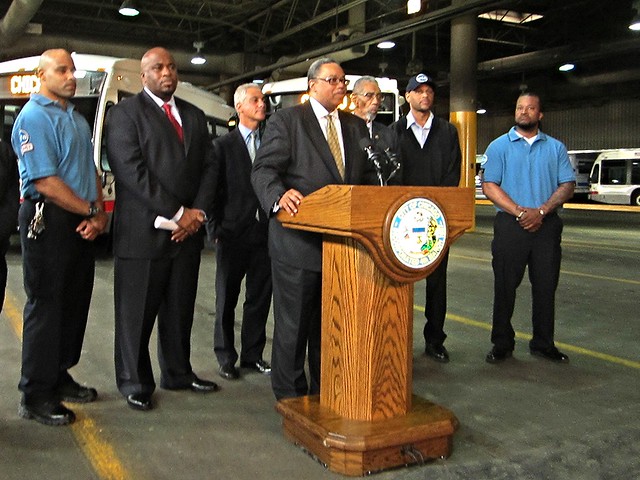Several of the last few Chicago Transit Authority presidents have had little or no background running a public transportation agency. However, Mayor Emanuel’s new pick to run the agency, Dorval R. Carter, Jr. has over 30 years of experience in transit at the city and federal levels.
In 2009, he spent a few months as an acting CTA president, and recently, he has served as an assistant to progressive U.S. Department of Transportation heads Ray LaHood and Anthony Foxx. He’ll start the job on May 18, and will be the first African-American CTA president in the agency's 68-year history.
Carter, who has a law degree from Howard University, started working at the CTA in 1984 as a staff attorney. Next, he worked as a lawyer for the Federal Transportation Administrations’ Midwestern regional office. After that, he worked in Washington, D.C. as the FTA’s Assistant Chief Council for Legislation and Regulation.
Carter returned to the CTA in 2000, eventually becoming Executive Vice President and Chief Administrative Officer, managing the $1 billion operating budget and five-year capital improvement program. After then-CTA president Ron Huberman stepped down in January 2009 to lead the Chicago Public Schools, Carter served as acting president for four months.
When President Obama appointed LaHood to lead the USDOT that year, LaHood brought Carter back to Washington. Most recently, Carter served as Acting Chief of Staff to current USDOT secretary Foxx, who endorsed him for the new CTA job. “He possesses the experience and passion for transit that will make him highly effective,” Foxx said in a statement. “Mayor Emanuel has made an excellent choice.”
At a press event yesterday, Emanuel praised the accomplishments of outgoing CTA President Forrest Claypool, who is leaving to serve as the mayor’s chief of staff, including rehabs of the Red and Blue lines, numerous station reconstructions, and launching the Loop Link bus rapid transit project. Emanuel also noted that there have been no fare raises under Claypool, and the agency has not raided its infrastructure budget to pay operating expenses, as has happened under past CTA chiefs.
Emanuel noted that Carter has received promotions at every position he’s held at the CTA and the USDOT. The mayor listed Carter’s qualifications for the new job as “his capacity to manage, set a vision, execute that vision, and literally keep the trains running on time.”
The mayor also said Carter’s D.C. connections will be valuable for winning federal funding for local transit projects. “I now have an ally who can work his Rolodex like mine, and we can actually now have a tag team to go get that money.”
In turn, Carter lauded Emanuel and Claypool’s work to improve Chicago’s public transportation system, and promised to build on those achievements. “During the course of my 30-year career, I have devoted myself to supporting transit,” he said. “I will do my best to bring forth the funding necessary to make the CTA a first-class transit system.” He later clarified his remark, saying that he feels the system is already first-class, and he wants to keep it that way.
Asked about his agenda for the CTA, Carter noted that he is still currently working at the DOT, and it will take him some time to get his bearings in the position. When I asked for his thoughts on the Ashland BRT proposal, Emanuel fielded the question, reiterating that after the Loop Link system is running, the city will evaluate its success and then make a decision about Ashland.
Later, Carter told me he is well acquainted with bus rapid transit via his work at the USDOT. “I have been involved with BRT projects from a funding standpoint. These projects are all over the country.”
Active Transportation Alliance director Ron Burke told me he’s confident that Carter will be able to run the agency competently, but he hopes the new chief will also push the envelopment by implementing bold initiatives like the Ashland BRT. "Mr. Carter is clearly capable of managing CTA, but Chicago needs more than a day-to-day manager. We need a visionary who can seize upon the growing demand for more and better transit to create a transit network that serves more people and generates more jobs. The status quo of slow buses and outdated hub-and-spoke rapid transit is not the answer.”





